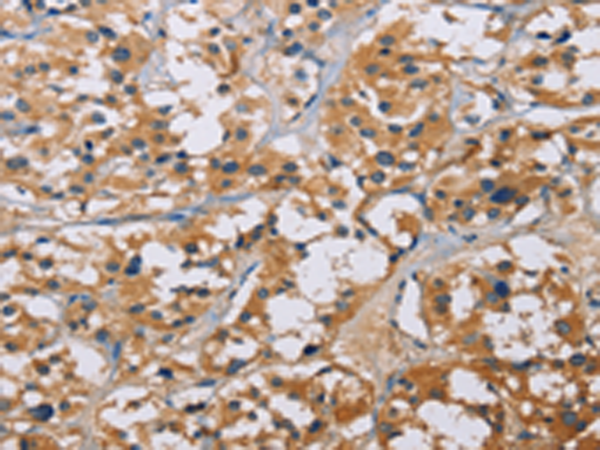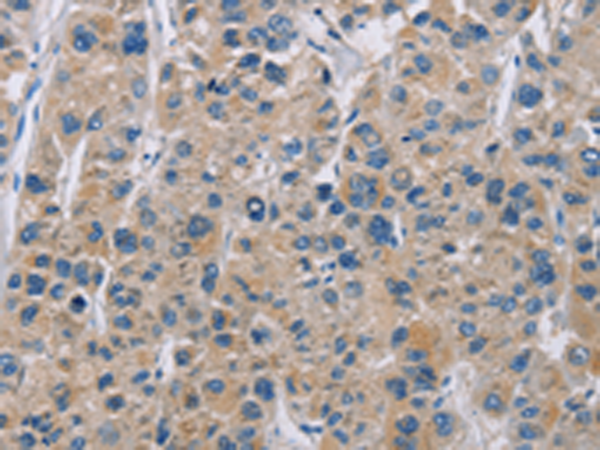

| WB | 咨询技术 | Human,Mouse,Rat |
| IF | 咨询技术 | Human,Mouse,Rat |
| IHC | 1/50-1/200 | Human,Mouse,Rat |
| ICC | 技术咨询 | Human,Mouse,Rat |
| FCM | 咨询技术 | Human,Mouse,Rat |
| Elisa | 1/2000-1/5000 | Human,Mouse,Rat |
| Aliases | NM23H5; RSPH23; NM23-H5 |
| Host/Isotype | Rabbit IgG |
| Antibody Type | Primary antibody |
| Storage | Store at 4°C short term. Aliquot and store at -20°C long term. Avoid freeze/thaw cycles. |
| Species Reactivity | Human, Mouse |
| Immunogen | Fusion protein of human NME5 |
| Formulation | Purified antibody in PBS with 0.05% sodium azide and 50% glycerol. |
+ +
以下是关于NME5抗体的3篇示例文献(内容基于公开研究概括,建议通过学术数据库核实最新进展):
---
1. **文献名称**:*NME5 regulates sperm flagellar motility and male fertility through its interaction with the axonemal microtubules*
**作者**:Li et al. (2018)
**摘要**:该研究利用特异性NME5抗体,通过免疫荧光和Western blot技术,揭示了NME5蛋白在精子鞭毛轴丝微管结构中的定位,并证明其缺失会导致精子运动障碍和男性不育。抗体验证表明NME5在睾丸组织中高表达。
---
2. **文献名称**:*NME5 suppresses cancer metastasis by modulating the Hippo signaling pathway*
**作者**:Ferguson et al. (2017)
**摘要**:通过开发高特异性NME5单克隆抗体,研究者发现NME5在乳腺癌中低表达,且与患者预后不良相关。实验表明NME5通过结合Hippo通路核心激酶LATS1.抑制肿瘤细胞迁移和侵袭。
---
3. **文献名称**:*Mitochondrial NME5 interacts with STING to regulate innate immune signaling*
**作者**:Sukumar et al. (2020)
**摘要**:本研究利用NME5抗体进行免疫共沉淀(Co-IP)和亚细胞定位分析,发现线粒体中的NME5能与STING蛋白相互作用,负调控抗病毒免疫反应,为自身免疫疾病治疗提供了新靶点。
---
**建议**:可通过 **PubMed** 或 **Google Scholar** 搜索关键词“NME5 antibody”、“NME5 function”获取更多具体文献,并关注近年研究(如2022-2023年)以更新信息。
The NME5 antibody targets the NME5 protein, a member of the NME/NM23 nucleoside diphosphate kinase family. Initially identified for its role in nucleotide metabolism, the NME family is broadly associated with cellular processes like proliferation, differentiation, and metastasis. NME5 (also called NDK5 or NM23-H5) stands out due to its unique structure, including a C-terminal domain absent in other family members, and its lack of enzymatic kinase activity. Research suggests it functions as a transcriptional regulator, influencing gene expression through interactions with DNA or transcription factors.
NME5 is predominantly expressed in reproductive tissues, particularly the testes, where it plays a critical role in sperm maturation and fertility. Mutations or dysregulation of NME5 are linked to male infertility, as seen in cases of teratozoospermia (abnormal sperm morphology). Beyond reproduction, NME5 has been implicated in cancer biology. Its aberrant expression correlates with tumor progression in ovarian, breast, and prostate cancers, potentially affecting metastasis and chemoresistance.
Antibodies against NME5 are vital tools for studying its localization, expression patterns, and molecular interactions. They enable diagnostic applications, such as detecting protein levels in clinical samples, and therapeutic research, including targeting pathways involving NME5 in infertility or oncology. Ongoing studies aim to clarify its dual roles in fertility and disease, positioning NME5 as a potential biomarker or therapeutic target.
×